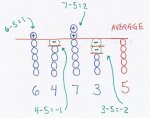Hi. I'm taking a stats class and the teacher gave us a question regarding deviation scores x-xbar=0
The question the teacher gave us is to mathematically prove this formula. I don't quite understand how to do this. She said that the sums of scores and equation for the mean are part of this??????
Can anyone help me????
--pc
The question the teacher gave us is to mathematically prove this formula. I don't quite understand how to do this. She said that the sums of scores and equation for the mean are part of this??????
Can anyone help me????
--pc

